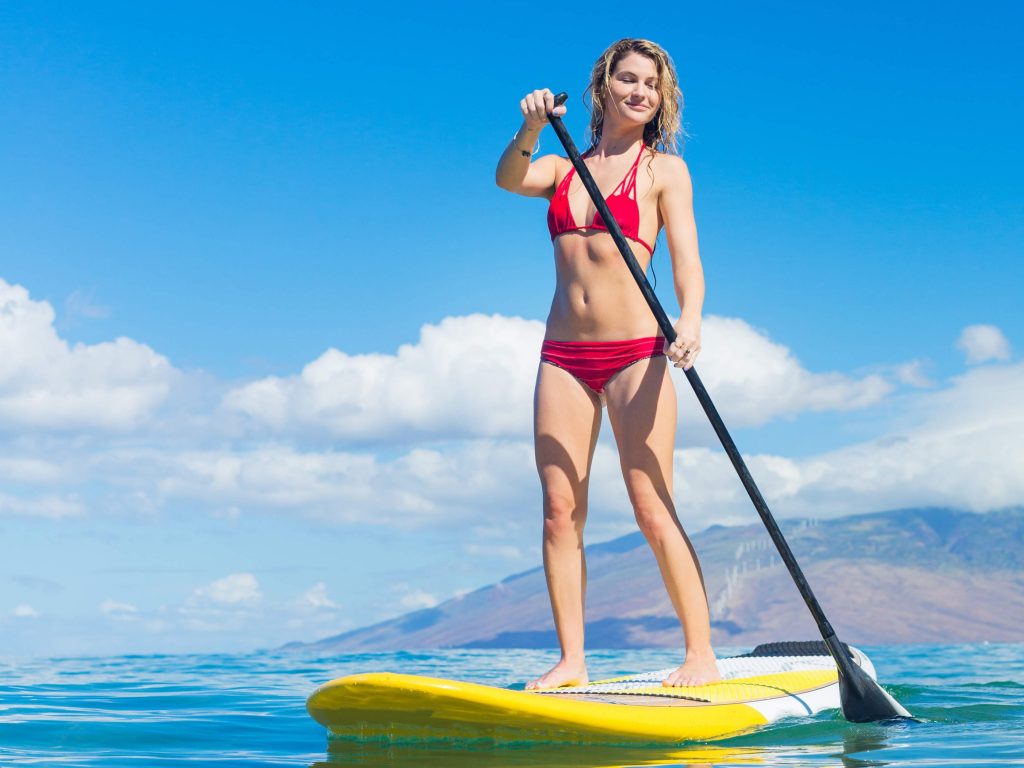PaddleboardingMany have described stand up paddleboards or ‘SUPs’ as the fastest growing trend in the world of water sports. Considering the fact that if you saw somebody stand on a board and start to paddle 20 years ago you probably would have been more than a bit confused, the sport has become pretty mainstream.

Legend has it that Hawaiian surfer Laird Hamilton in the 90s started paddling with a canoe paddle on his biggest surfboard to try and bulk up for big waves. He found it to be great exercise and it stuck. While this is likely one of the reasons it is so popular today, SUP’s of some form have been used in Hawaii, South America and Africa for thousands of years. Hawaiians describe it as Hoe He’e Nalu, a term you’re likely to hear if you visit the surfing hotspot.
So why has it caught on so much? Well, as already briefly mentioned, it is great exercise for a few different reasons. As well as the balance and weight distribution in your legs, your upper body gets a workout whilst propelling you across the water. Paddle boarding is a great way to vary what you’re doing on the water and give different muscles a workout. On top of this, it isn’t the most intimidating of board sports. If you look at a surfer or skimboarder for instance it can be intimidating, and a huge amount of skill is required to reach the top level. Paddleboarding isn’t easy as such, but it is more simple to pick up the basics and start to propel yourself along.
So You Want to Start Paddleboarding
There are so many places you can get started with your SUP adventure. Choose a lake, river or coast with pretty tame waters for your first trip and make sure it isn’t too windy. There are a few pieces of equipment you absolutely need to start off. These can sometimes be rented from water sports stores but buying a beginner model doesn’t have to cost the earth and if you plan to head out regularly it can be well worth it.
- The Board – you need a board, and a suitable one for your size. Some boards come in multiple sizes, and all will tell you how big they are before you buy it, the bigger the board, generally the more stability you will have.
- Paddle – you need a paddle to propel yourself, this will sometimes come as part of a set with the board. They can be made of fiberglass or metal materials.
- Leash – this is vital and will ensure that the paddle doesn’t get lost! If you drop it in the water it can be hard to ever get back, and you don’t want to make a habit of losing your paddles.
- Life Jacket or Life Vest – as always with any water sport, you have to take the adequate safety precautions.
Tips for SUP Beginners
- Keep an eye on the weather. There is nothing worse than finding yourself on the water in a storm or windy conditions if you’re not yet comfortable on your board. Be sure that you stay in calm waters.
- Face the right way. It sounds a bit rudimental but some beginners get confused which way to stand. The narrower ‘nose’ of the board should face the way you want to go, this is the front of the board.
- Long strokes, hold the top of the paddle. If you hold it at the bottom or like a broom you’re not going to get the most of the propulsion your body can create.
- Don’t rely on your arms. Most of the ‘heavy lifting’ should be done by your back. Ensuring you stay upright and looking forward rather than looking down will help this.
- Fall away from the board. If you fall on the board or manage to get it to fall on you, it hurts. If you feel yourself going, jump away from the board and fall straight into the water.
Conclusion
As well as being amazing fun, going out on an SUP can be an amazing exercise, and it is no wonder this is a hobby which is catching on as being one of the most popular water sports. It is an accessible sport and one you can get started with pretty simply. Follow our basic tips and have an amazing time on your board!
